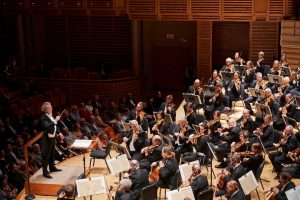
By Márcio Bezerra
For an orchestra that markets itself as “the best in America,” the concert given by the Cleveland Orchestra at the Kravis Center for the Performing Arts was only a partial success.
Playing for a (finally!) packed house, the venerable ensemble presented a conventional program performed with great technical prowess, but that ultimately failed to excite.
Under the baton of Music Director Franz Welser-Möst, the ensemble started the program with a contemporary work, Cleveland Pictures, by the late British composer Oliver Knussen. Inspired by four masterworks on display at the Cleveland Museum of Art (a nod to Mussorgsky’s Pictures at an Exhibition) they are coloristic numbers that make clever use of instrumental combinations, performed here with utmost attention to detail by the orchestra.
Unfortunately, the work is conventional at best and one would have appreciated a more advanced contemporary work — of which there is no shortage in the orchestra’s library.
Violinist Nikolaj Szeps-Znaider joined the group for the Violin Concerto No. 1 (in G minor, Op. 26) by Max Bruch. An audience favorite, Bruch’s one-time hit is remarkable for its passionate, beautiful melodies and dramatic interactions between soloist and orchestra.
Szeps-Znaider displayed a robust sound and refined technique. He was always coordinated with the orchestra, no matter how many times the tempi changed — a testimony to his double-duty as an accomplished conductor. His reading of the second movement, Adagio, was particularly remarkable thanks to his beautiful tone. The finale, marked Allegro energico, however, lacked the rhythmic drive that makes audiences jump to their feet at the last chord. As a result, Szeps-Znaider had to rush to ride on the fading applause for a curtain call.
The second half of the program consisted of the massive Symphony No. 5 (in B-flat Major, Op. 100) by Sergei Prokofiev. Written during World War II, its message is one of hope and faith in humanity. The work features Prokofiev’s penchant for writing tuneful, yet modern-sounding melodies. His command of orchestration is enviable and the naturalness of his writing is nothing short of astounding.
It is a technically and musically demanding work, which is maybe one of the reasons it has not been performed here often. The Cleveland Orchestra has all the qualities to deliver it well and well it did. The middle movements were particularly impressive, with clarinetist Afendi Yusuf shining in his solos during the second movement, which was taken on the faster side.
The following Adagio featured the most satisfying playing of the evening, with the string section’s flawless intonation even on stratospheric parts unchallenged. Once more, in the Finale, Welser-Möst failed to build up on the tension towards the end, finishing the symphony in a quite pedestrian way.
It was a missed opportunity and, for the first time, the infamous Kravis walking standing ovation felt appropriate.